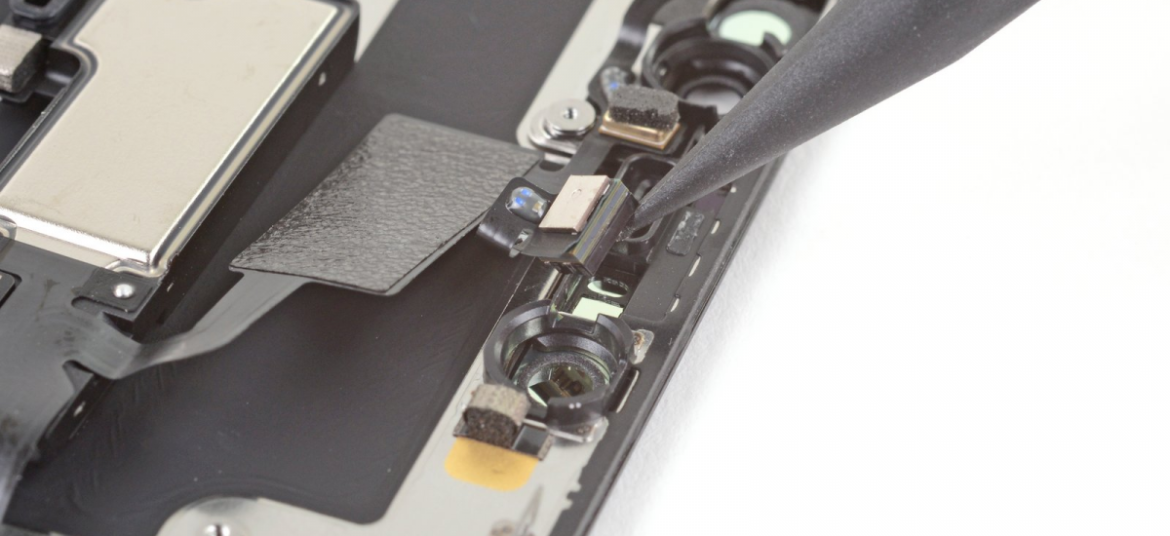

It can’t fully be said whether iOS 15.2 ‘fixes’ this issue, ‘corrects’ it, or ‘undoes’ it, because Apple won’t say whether it was due to a bug or a decision/experiment to make it even more difficult for the repair industry. When it announced that Face ID would no longer fail after (non-Apple-sanctioned) screen replacements, it did so with a single, non-attributed statement to The Verge about ‘a software update.’ There’s no mention of Face ID functionality or repairs in the official iOS 15.2 release notes.
When the public 15.2 release arrived, two genuine iPhone 13 Pro Max devices were set up. One as a testing unit and the other as the parts donor. The testing phone had all original parts, Face ID set up and working, battery health showing, True Tone working, and full camera functionality. The battery, rear camera, and screen were removed from the testing phone and replaced with parts from the donor phone. The testing phone was turned on, and there you have it: the device could unlock with Face ID



Then as expected, the warnings arrived, one after the other: “Important Camera Message,” “Important Battery Message,” “Important Display Message.” There’s an interestingly small, discrepancy between the warnings: it cannot “verify” the battery, rather than “determine” the screen or camera, and the concern is a genuine Apple “battery” rather than “part.” Our guess is that the battery warning is older and the copy hasn’t been updated. You can either dismiss the message with “OK” or “Go to Settings for more information.”
Click the “Settings” button, and you see a new section: “More for Your iPhone.” Here is where the “genuine” warnings hang out, along with nudges for you to finish setting up your iPhone.



Elsewhere, in the “About” section of Settings, you can see the new “Parts and Service History” that details the concerns Apple has about Unknown Parts in your phone. It states that “Apple has updated the device information for this iPhone.”
On Apple’s website, the remote logging is explicit: “This means that Apple has updated the device information maintained for this iPhone for service needs, safety analysis, and to improve future products.” And: “Information about parts and service history is collected by Apple and stored as part of the device information maintained for your iPhone. This information is used for service needs, safety analysis, and to improve future products.” When you move these major components between iPhones, using Apple tools or otherwise, Apple knows.
As seen before, in addition to these written warnings, there are real consequences to Apple’s concern. You lose Battery Health information, cluing you into when you should next replace your battery. And True Tone, or automatic display color calibration, is non-functional and missing from your Display & Brightness settings.
The testing iPhone which is now full of unkown parts is put back together with all its original paired parts, and turned on again. Now not only does Face ID work, Battery Health and True Tone return, and the iPhone no longer has a Parts and Service History at all. The section between the numbers on top and the Songs/Videos/Photos section below is simply gone. Apple, however, says it keeps a record.
The iPhone 13`s Face ID failures were first discovered durin the teardown of the iPhone 13 Pro. Further testing confirmed that it wasn’t a fluke. It made for a complicated narrative about iPhones and repairability.

The iPhone 13 was, physically, more repairable than the iPhone 12, because the Face ID scanner and front-facing camera components were no longer tied to other screen components. Having to transplant a combination speaker/sensor/scanner module from one screen to another, using heat and gentle prying, was a pain. Moving the Face ID module to a more easily removed bit in the iPhone 13 seemed like a concession to easier screen replacements. The dim future of iPhone repair, seemingly layered with serialized lockdowns, had a bright spot.
Lorem ipsum dolor sit amet, consectetur adipiscing elit. Ut elit tellus, luctus nec ullamcorper mattis, pulvinar dapibus leo.
mnbjmbn